Art
Indigenous Art Installation at Rideau Hall | The Governor General of Canada – Gouverneure générale du Canada
Art is a beautiful way to tell stories, and to illustrate history, culture and traditions. Engaging with art allows us to be part of a global community where we can learn from a multitude of perspectives and ideas.
Rideau Hall is proud to host a series of Indigenous artworks on loan from the Indigenous Art Centre. The grouping of these artworks is centred on storytelling, with each artist using their unique perspective to illustrate life, traditions, mythology, Inuit legends or wildlife.
For a limited time, these artworks are on display in the Ballroom and Reception Room at Rideau Hall, located only a few minutes from downtown Ottawa and Gatineau. The exhibit is part of the free guided tour of the residence, and will be on display until fall 2023.
Plan your visit today!
Ballroom
The Ballroom at Rideau Hall is where the governor general welcomes Canadian and foreign dignitaries, and honours Canadians who have done something exceptional for their country or community. State dinners, investiture ceremonies and many other official functions take place in this room.
On the south wall of the Ballroom is a triptych entitled Murmur. The artist, Meryl McMaster, is known for combining performance and photography in her work. Her performative self-portraits present journeys that are both actual and imaginative, into the realms of her ancestors.
Murmur, 2013
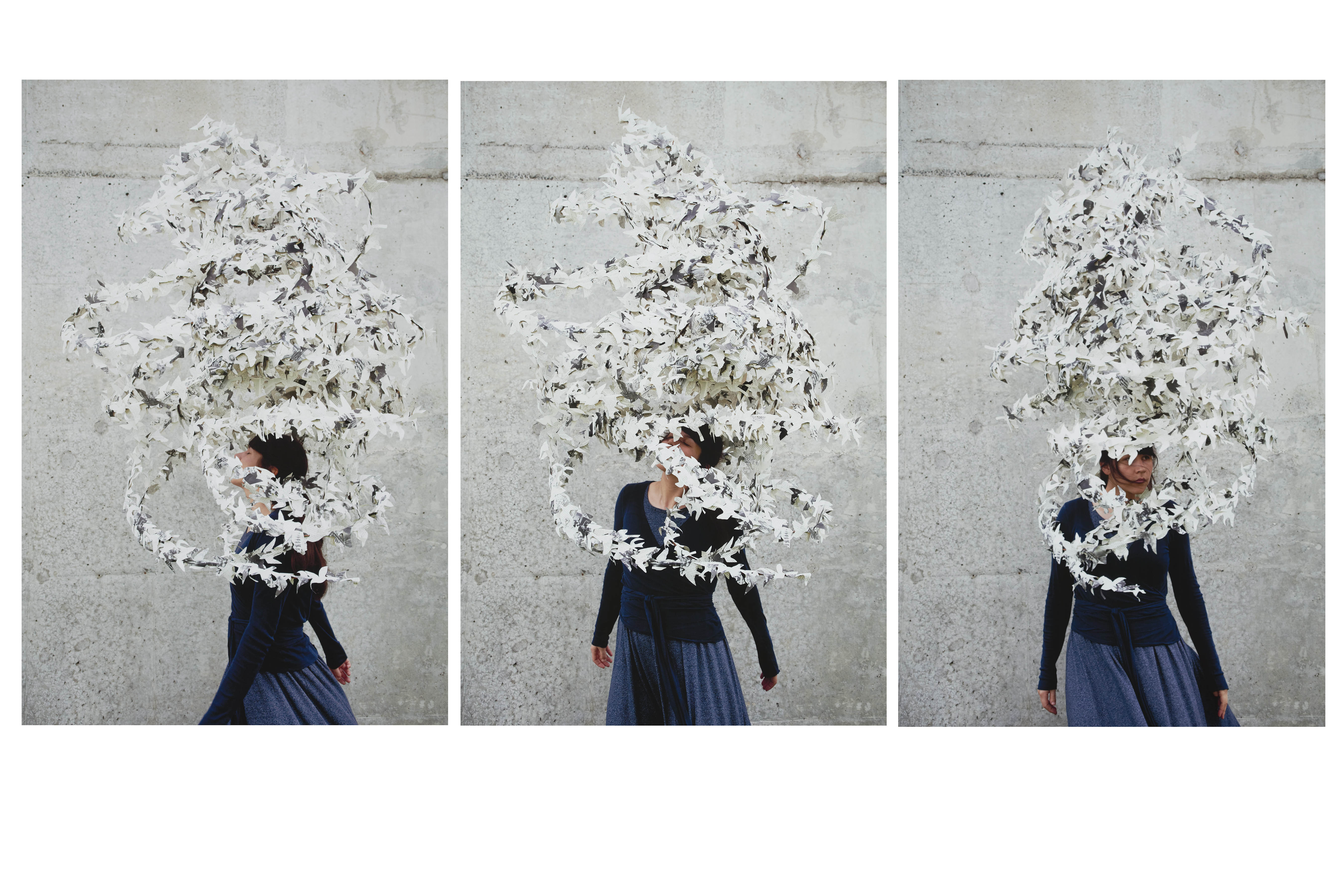

Open larger version in new tab
Meryl McMaster (Ottawa, ON, 1988)
Murmur (2013), Ink jet print on paper
Loan from the Indigenous Art Centre, Crown-Indigenous Relations and Northern Affairs Canada
Reproduced with the permission of Meryl McMaster
Meryl McMaster is of nêhiyaw (Plains Cree, from Red Pheasant Cree Nation), British and Dutch ancestry, and is a member of the Siksika First Nation. She is well known for her large-format self-portraits that feature themes of self through land, lineage, history and culture. Murmur was inspired by the natural phenomenon of a murmuration, a mass of starlings that fly together as one. In this triptych, the artist is surrounded by thousands of paper ‘starlings’ flying around her, cut from North American history books. This art piece is meant to demonstrate the reclaiming of history and our discontent with it.
Reception Room
The Reception Room is a part of the original villa built by Thomas MacKay in 1838. Today, guests attending ceremonial events in the Ballroom are received in this room. Smaller official ceremonies often take place in the Reception Room as well.
The Reception Room exhibit features Inuit art that is centred on storytelling, through prints and drawings that narrate life in the Arctic, traditions, mythology, Inuit legends and wildlife. Each piece touches on the fragility of the environment and communicates messages about the sacred nature of the land.
Beginning in the late 1940s and ongoing today more than ever, Inuit artists—in the Northwest Territories, Nunavut, Nunavik (northern Quebec) and Nunatsiavut (Newfoundland and Labrador)—have contributed to a flourishing art market with their sculptures, drawings, printmaking and work in other media. Their art addresses issues of identity and aesthetics, and tell compelling stories of cross-cultural interaction.
Caribou Woman, 2000
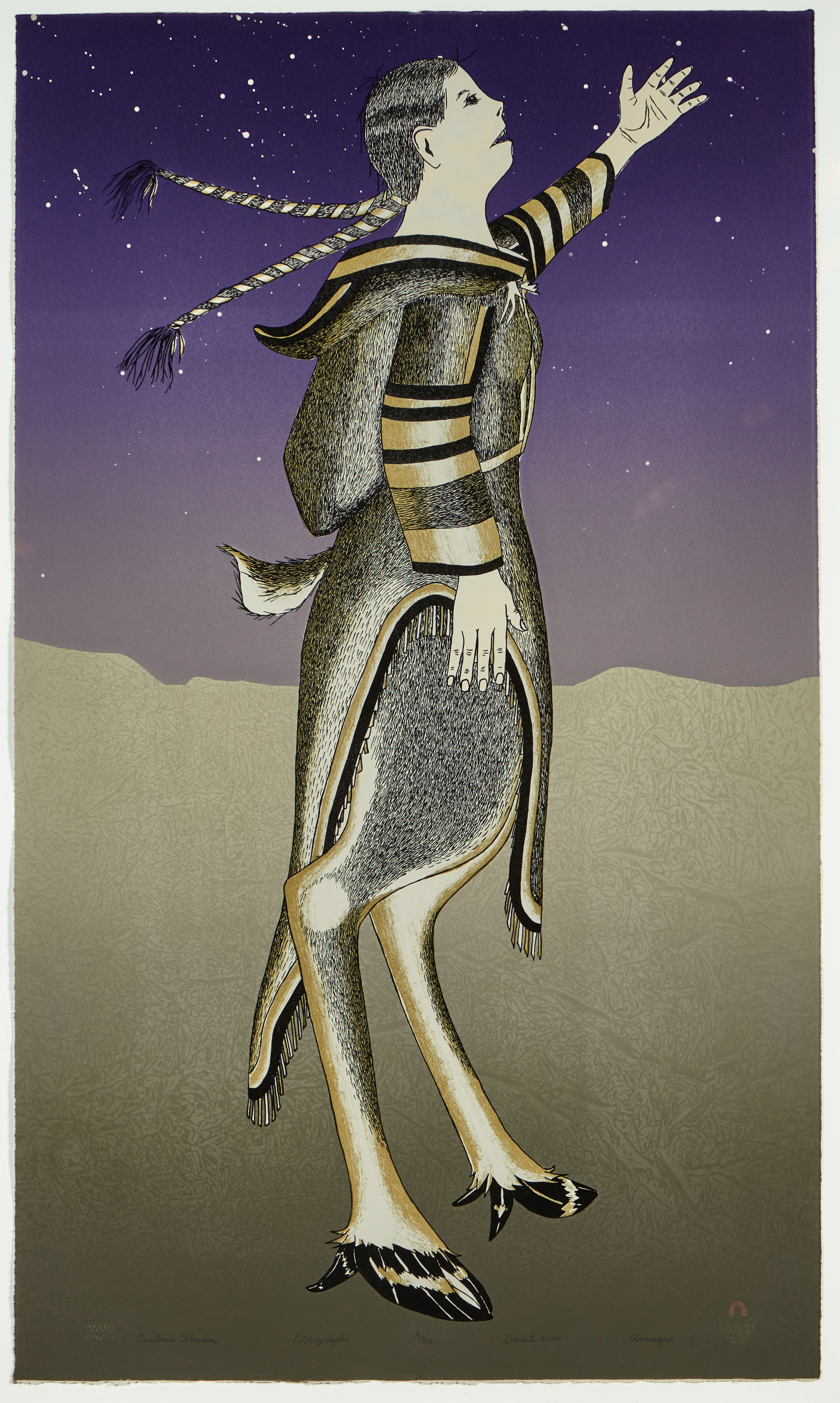

Open larger version in new tab
Arnaquq Ashevak (Keatuk, NU, 1956 – 2009, Iqaluit, NU)
Caribou Woman, 2000, lithograph on paper
Loan from the Indigenous Art Centre, Crown-Indigenous Relations and Northern Affairs Canada
Reproduced with the permission of Dorset Fine Arts
Arnaquq (Arnaqu) Ashevak was a multidisciplinary artist renowned for his three-dimensional work. His print, Caribou Woman, represents a transformation scene, where animal and human bodies merge together to create a new life form. As meaningful topics in Inuit cosmology and shamanism, transformation scenes represent the universe’s three realms: one for the living, one for the dead and one for spirits.
At the Fish Weir, 1999
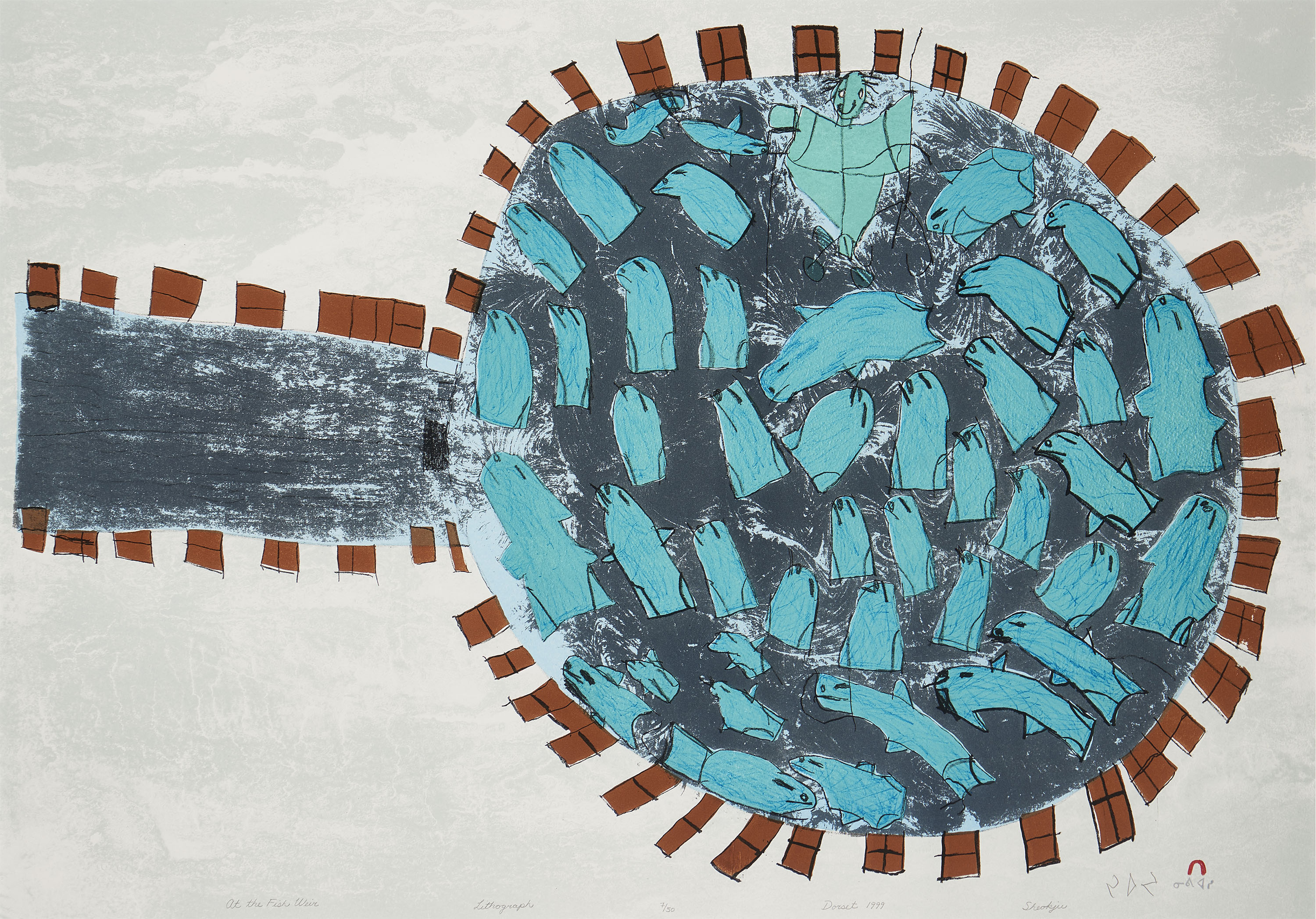

Open larger version in new tab
Sheojuk Etidlooie (Akkuatuloulavik outpost camp, NU, 1929 – 1999, Cape Dorset, NU)
At the Fish Weir, 1999, lithograph on paper
Loan from the Indigenous Art Centre, Crown-Indigenous Relations and Northern Affairs Canada
Reproduced with the permission of Dorset Fine Arts
Sheojuk Etidlooie’s artistic career began when she was 60 years old, and only lasted seven years. She created an unusual and important body of works on paper unlike anything else coming out of Cape Dorset at that time. Animals, including dogs, caribou, fish, seals and birds, were her most frequent subjects. At the Fish Weir depicts a barrier placed in the river to direct the passage of—and trap—fish.
Untitled, 2016


Open larger version in new tab
Qavavau Manumie (Brandon, MB, 1958)
Untitled, 2016, colour pencil and ink on paper
Loan from the Indigenous Art Centre, Crown-Indigenous Relations and Northern Affairs Canada
Reproduced with the permission of Dorset Fine Arts
Qavavau Manumie was born in Brandon, Manitoba, but moved to Cape Dorset, Nunavut, at a young age. His work often depicts Inuit legends and mythology, Arctic wildlife and contemporary aspects of Inuit life in unique and amusing ways. Manumie’s imaginative style often combines both reality and fantasy, as depicted in Untitled.
Floe Edge Stories, 2016
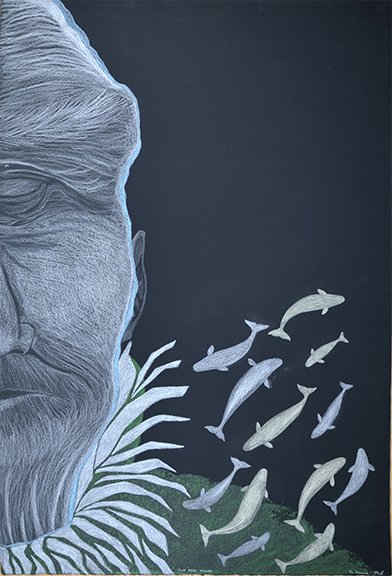

Tim Pitsiulak (Kimmirut, NU, 1967 – 2016, Iqaluit, NU)
Floe Edge Stories, 2016, graphite and colour pencil
Loan from the Indigenous Art Centre, Crown-Indigenous Relations and Northern Affairs Canada
Reproduced with the permission of Dorset Fine Arts
Tim Pitsiulak’s drawing and printmaking was inspired by the natural beauty he saw on his hunting expeditions. Floe Edge Stories shows Pitsiulak’s respect for nature and wildlife. Using elements of Inuit mythology, he used a textured drawing technique to give human form to the Arctic’s floe edge, or “sinaaq” in Inuktitut. The floe edge, also known as the “line of life,” is where ice attached to the shoreline meets the water, creating a wonderful and dynamic ecosystem for Arctic mammals.
Winsome Owl, 2013
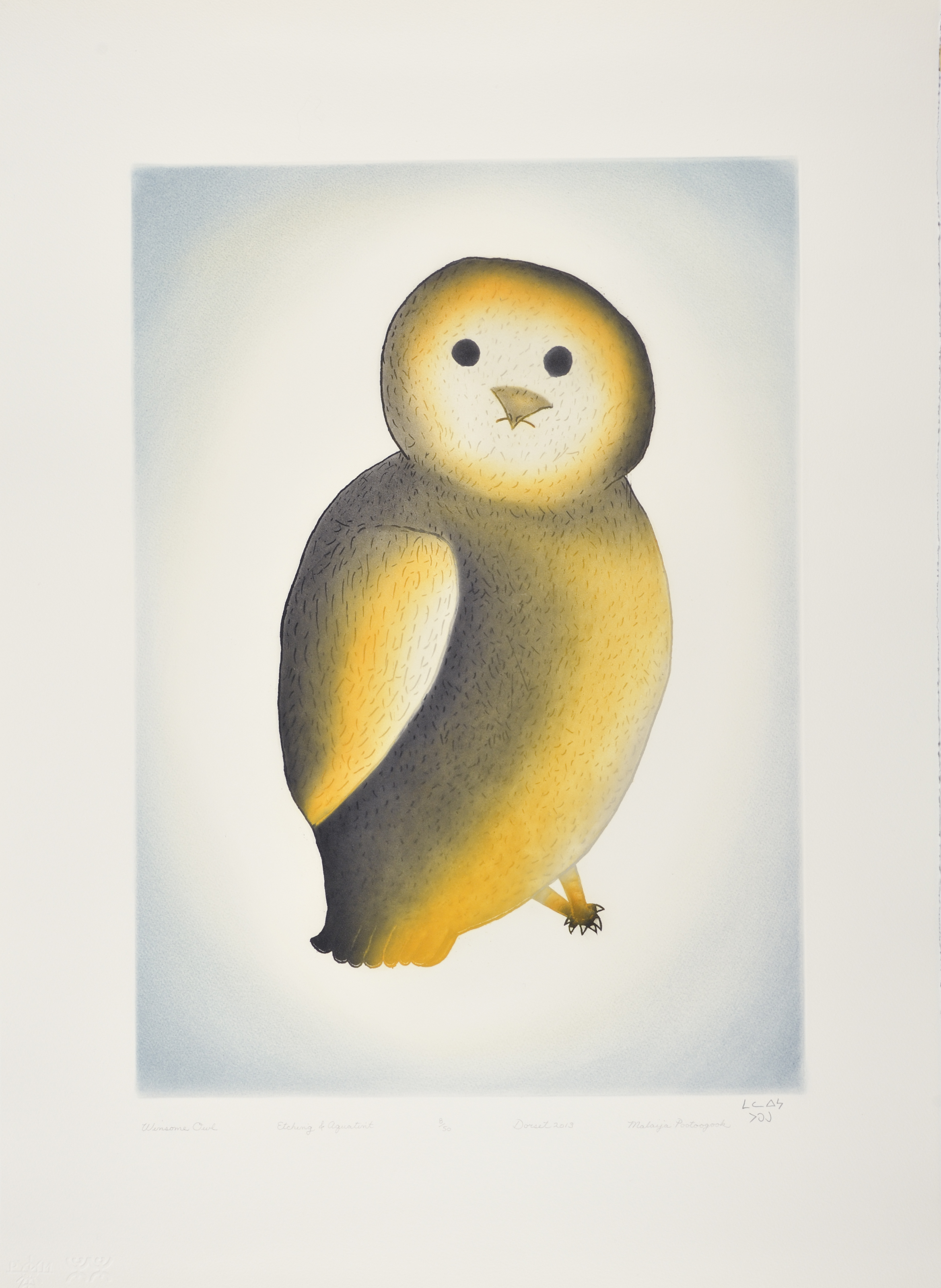

Open larger version in new tab
Malaija Pootoogook (Iqaluit, NU, 1971 – 2021)
Winsome Owl, 2013, etching and aquatint on paper
Loan from the Indigenous Art Centre, Crown-Indigenous Relations and Northern Affairs Canada
Reproduced with the permission of Dorset Fine Arts
Born in Iqaluit, Malaija (Malaiya) Pootoogook was inspired by the work of her great-grandmother, Pitseolak Ashoona. Expressive depictions of birds and Arctic wildlife were a continuous theme in her work. Her style evolved from contour lines and minimal etching to include vibrant colours, seen here in Winsome Owl.
Sedna’s Creation, 2019
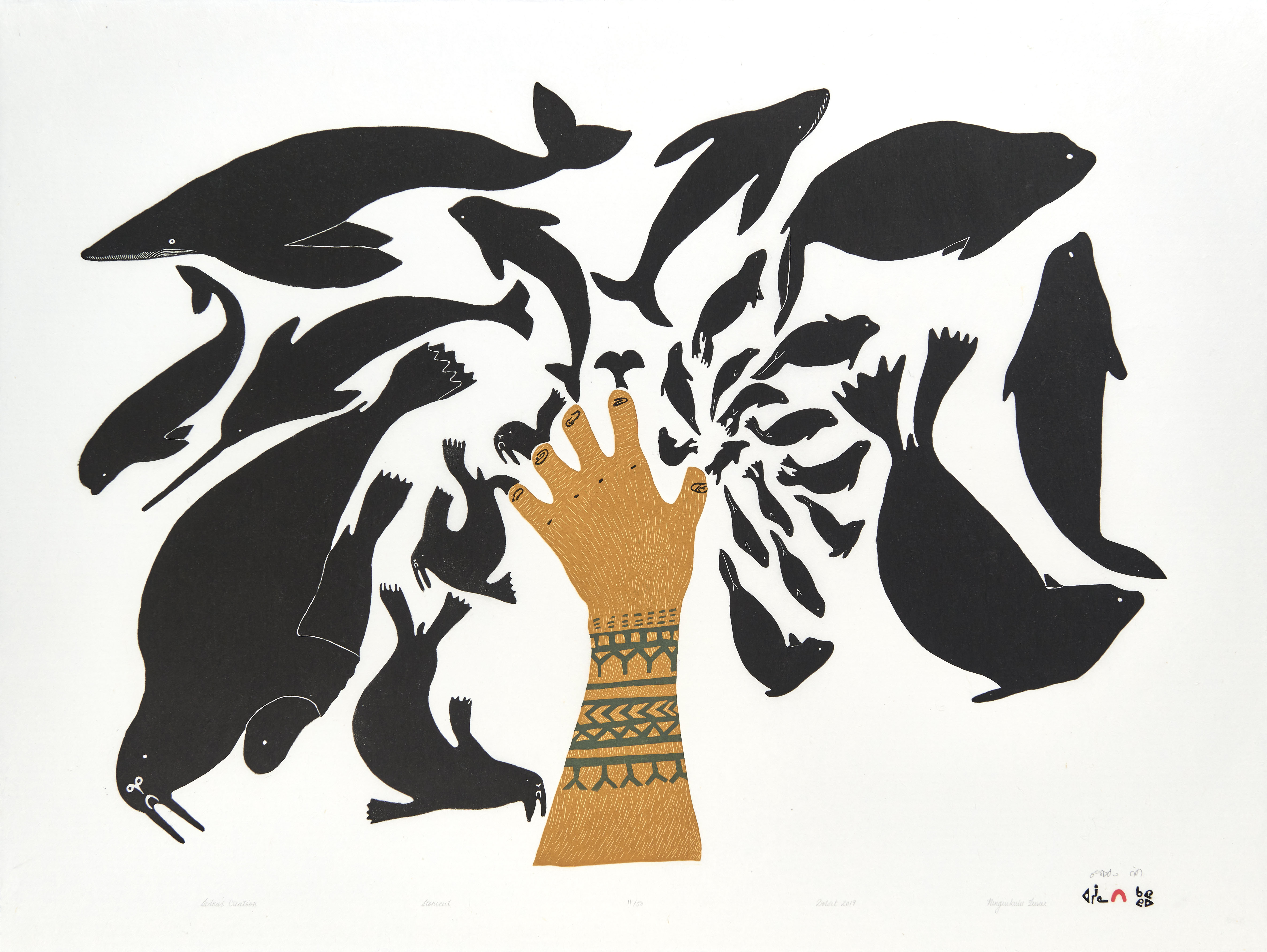

Open larger version in new tab
Ningiukulu Teevee (Cape Dorset, NU, 1963)
Sedna’s Creation, 2019, stonecut on paper
Loan from the Indigenous Art Centre, Crown-Indigenous Relations and Northern Affairs Canada
Reproduced with the permission of Dorset Fine Arts
Ningiukulu Teevee’s art is often inspired by Inuit legends. Her piece Sedna’s Creation captures a key moment in the myth of Sedna, goddess of the sea. Her fingers transform into marine creatures, providing a plentiful bounty for Inuit. Sedna also has the power to either create violent storms or to calm the sea. The story of Sedna continues to serve as a reminder to hunt responsibly and to live in balance with nature.
Man and Wife, 1979
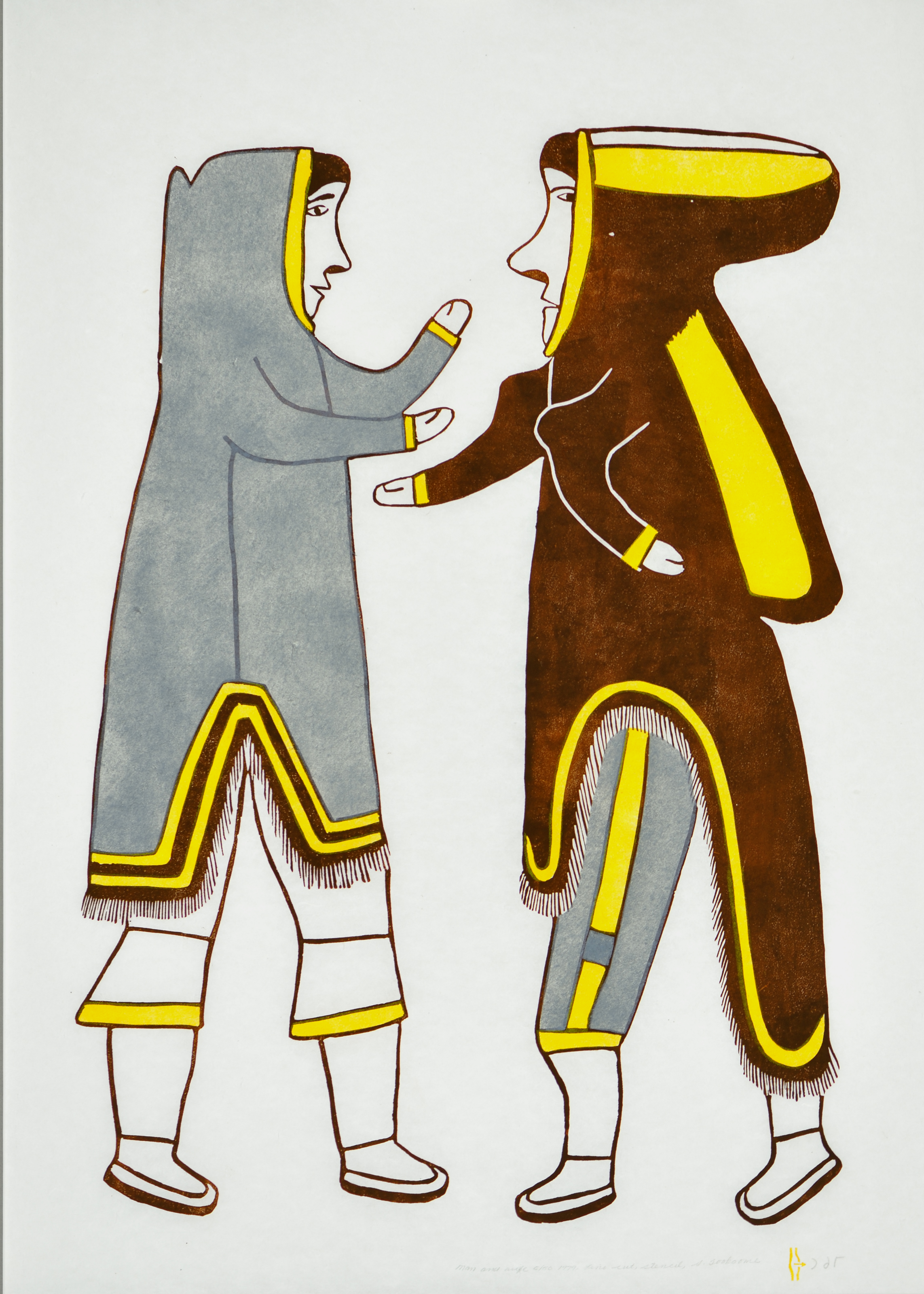

Open larger version in new tab
Simon Tookoome (Chantrey Inlet, NU, 1934 – 2010, Baker Lake, NU)
Man and Wife, 1979, linocut and stencil on paper
Loan from the Indigenous Art Centre, Crown-Indigenous Relations and Northern Affairs Canada
Reproduced with the permission of the Estate of Simon Tookoome
Throughout his lifetime, Simon Tookoome was a fisher, builder, teacher, jeweller, artist and carver whose skills were imbued with traditional Inuit knowledge. Tookoome’s drawings often focused on symmetry and balance, as seen in Man and Wife, wherein the figures are arranged in a near-perfect mirrored composition.
Art
This N.B. artist joined an online movement. Now her art is being shown across the world. – CBC.ca
Since joining a community that dreams of an internet free from giant corporations that can exploit users’ time and data, Victoria West’s digital artwork has been exhibited across the globe.
West, a photographer and digital artist based in Burton, 30 kilometres southeast of Fredericton, has had her work shown in Paris, Rome, Barcelona, Townsville in northeastern Australia, Miami, New York City, and even a museum in Albuquerque, N.M., — all through connections she’s made in Web3.
West warned it was a “rabbit hole,” but what she found in wonderland she doesn’t believe she’d find anywhere else.
Web3 is a future version of the internet.
The work of Victoria West, a photographer and digital artist based in Burton, was recently showcased at an immersive exhibit in the Big Apple.
Web1, West said, was the first version of the internet, in which users passively consumed information.
As the 2000s dawned, Web2 emerged, and users could now post their own content — think Twitter, blogs, YouTube. People are now creating more and more in digital spaces, but the downside of Web2 is that corporations are technically still the owners of all that creation, and they could take your data and potentially do with it as they please.
Enter Web3, which still exists more in theory: nobody and everybody owns the internet. This version aims to be decentralized. It doesn’t eradicate the distrust some people have in mega companies like Google and Meta — it just removes the need for it, because no one person or organization can own the blockchain Web3 operates on.
West said within Web3 there’s an art movement, with artists working together and taking control of their work. Imagine if Leonardo da Vinci had an internet connection, as well as Raphael, Michelangelo and Donatello. It’s the renaissance all over again, West said, except it’s happening with digital art.
“And it’s happening online on a much bigger scale.”
Before learning about W3 in 2021, West said she was in a photography bubble.


Photography isn’t the art form West imagined herself pursuing when she was younger. But when she bought a camera after the first commercial digital models arrived on the market in the mid-2000s, she was hooked.
“I was bothering everybody around me to take their portrait,” she said.
She built up her portraiture business, becoming involved with the Professional Photographers of Canada and competing in photography contests. Still, West didn’t want to just capture moments — she wanted to make them.


That’s when artificial intelligence came on the scene.
West was using Midjourney, a generative AI program, when it was still in beta testing. Around the same time she became involved with Web3, she experimented with blending AI-produced textures into her photography. In her business, AI quickened her workflow and allowed her to change backdrops and furniture.
While creating a piece in 2023 called When I Die, West wanted to design a man underground with roots blossoming into a tree. Well, there aren’t any blossoming trees in Canada in February, West joked — so she made the tree using AI.
“I feel like someone took handcuffs off me, and I’m free,” she said.


Lauren Cruikshank, an associate professor in culture and media studies at the University of New Brunswick, has spoken about the use of AI in universities, but she also thinks about it through an artistic lens.
From the camera to spell check, Cruikshank said the same discussion happens with each new medium: how much of the artistry belongs to the artist, how much to the tools they’re using?
“For some people where it gets uncomfortable is where the role of the human is minimal compared to how much the AI tool is creating or having creative influence,” she said.
With AI, Cruikshank agreed there are degrees — there’s a difference between prompting an AI to generate an image of a beautiful sunset and claiming it as your artwork and what West is doing, combining AI with her own artistry.
“That sounds really compelling to me,” Cruikshank said.


When West first saw Lume Studios on Broadway in lower Manhattan, the place she’d eventually display Eden’s Dye, her immersive art exhibit, she knew she wanted it immediately.
She collaborated on the exhibit with some of her Web3 friends. Los Angeles actors and poets Laurence Fuller and Vincent D’Onofrio wrote poetry to accompany each piece of art, which West created using both photography and AI. A coder friend joined the crew, and the result was a floor-to-ceiling immersive exhibit. West’s collaborators also choreographed performances to complement the art, using music produced by AI.
“Why wouldn’t I do that if I can?” West asked. “It’s freeing, I think, and lets you push the boundaries of photography and what you can do with it.”
While the exhibit leaned heavily on romantic, classical themes and Baroque aesthetics, Eden’s Dye is almost a premonition: minted, digital artwork taking up entire walls in people’s homes, flowers growing from code, experiencing art in virtual realms.
Demand will only grow, West said. Technology will progress and the internet will change. But what she really wanted was for people to walk into Eden’s Dye and be amazed by the art they were experiencing.
“They came because of the art, and they were there enjoying the art. You don’t really need to understand anything beyond that.”
Art
Niagara quilt expo to explore history of modern art form – Welland Tribune
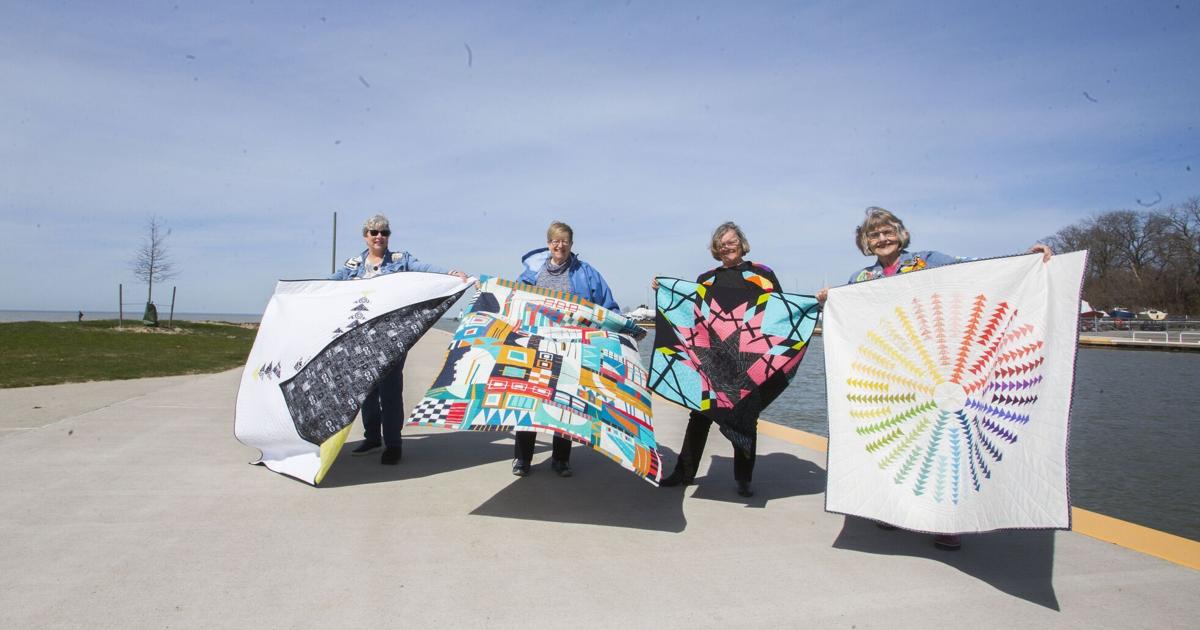

/* OOVVUU Targeting */
const path = ‘/things-to-do’;
const siteName = ‘wellandtribune.ca’;
let domain = ‘thestar.com’;
if (siteName === ‘thestar.com’)
domain = ‘thestar.com’;
else if (siteName === ‘niagarafallsreview.ca’)
domain = ‘niagara_falls_review’;
else if (siteName === ‘stcatharinesstandard.ca’)
domain = ‘st_catharines_standard’;
else if (siteName === ‘thepeterboroughexaminer.com’)
domain = ‘the_peterborough_examiner’;
else if (siteName === ‘therecord.com’)
domain = ‘the_record’;
else if (siteName === ‘thespec.com’)
domain = ‘the_spec’;
else if (siteName === ‘wellandtribune.ca’)
domain = ‘welland_tribune’;
else if (siteName === ‘bramptonguardian.com’)
domain = ‘brampton_guardian’;
else if (siteName === ‘caledonenterprise.com’)
domain = ‘caledon_enterprise’;
else if (siteName === ‘cambridgetimes.ca’)
domain = ‘cambridge_times’;
else if (siteName === ‘durhamregion.com’)
domain = ‘durham_region’;
else if (siteName === ‘guelphmercury.com’)
domain = ‘guelph_mercury’;
else if (siteName === ‘insidehalton.com’)
domain = ‘inside_halton’;
else if (siteName === ‘insideottawavalley.com’)
domain = ‘inside_ottawa_valley’;
else if (siteName === ‘mississauga.com’)
domain = ‘mississauga’;
else if (siteName === ‘muskokaregion.com’)
domain = ‘muskoka_region’;
else if (siteName === ‘newhamburgindependent.ca’)
domain = ‘new_hamburg_independent’;
else if (siteName === ‘niagarathisweek.com’)
domain = ‘niagara_this_week’;
else if (siteName === ‘northbaynipissing.com’)
domain = ‘north_bay_nipissing’;
else if (siteName === ‘northumberlandnews.com’)
domain = ‘northumberland_news’;
else if (siteName === ‘orangeville.com’)
domain = ‘orangeville’;
else if (siteName === ‘ourwindsor.ca’)
domain = ‘our_windsor’;
else if (siteName === ‘parrysound.com’)
domain = ‘parrysound’;
else if (siteName === ‘simcoe.com’)
domain = ‘simcoe’;
else if (siteName === ‘theifp.ca’)
domain = ‘the_ifp’;
else if (siteName === ‘waterloochronicle.ca’)
domain = ‘waterloo_chronicle’;
else if (siteName === ‘yorkregion.com’)
domain = ‘york_region’;
let sectionTag = ”;
try
if (domain === ‘thestar.com’ && path.indexOf(‘wires/’) = 0)
sectionTag = ‘/business’;
else if (path.indexOf(‘/autos’) >= 0)
sectionTag = ‘/autos’;
else if (path.indexOf(‘/entertainment’) >= 0)
sectionTag = ‘/entertainment’;
else if (path.indexOf(‘/life’) >= 0)
sectionTag = ‘/life’;
else if (path.indexOf(‘/news’) >= 0)
sectionTag = ‘/news’;
else if (path.indexOf(‘/politics’) >= 0)
sectionTag = ‘/politics’;
else if (path.indexOf(‘/sports’) >= 0)
sectionTag = ‘/sports’;
else if (path.indexOf(‘/opinion’) >= 0)
sectionTag = ‘/opinion’;
} catch (ex)
const descriptionUrl = ‘window.location.href’;
const vid = ‘mediainfo.reference_id’;
const cmsId = ‘2665777’;
let url = `https://pubads.g.doubleclick.net/gampad/ads?iu=/58580620/$domain/video/oovvuu$sectionTag&description_url=$descriptionUrl&vid=$vid&cmsid=$cmsId&tfcd=0&npa=0&sz=640×480&ad_rule=0&gdfp_req=1&output=vast&unviewed_position_start=1&env=vp&impl=s&correlator=`;
url = url.split(‘ ‘).join(”);
window.oovvuuReplacementAdServerURL = url;
These aren’t your grandma’s quilts.
Being a grandmother herself, Lorna Costantini said she’s not a huge fan of the above phrase, but she can’t help but use it to describe modern quilting.
Art
Art and Ephemera Once Owned by Pioneering Artist Mary Beth Edelson Discarded on the Street in SoHo – artnet News
This afternoon in Manhattan’s SoHo neighborhood, people walking along Mercer Street were surprised to find a trove of materials that once belonged to the late feminist artist Mary Beth Edelson, all free for the taking.
Outside of Edelson’s old studio at 110 Mercer Street, drawings, prints, and cut-out figures were sitting in cardboard boxes alongside posters from her exhibitions, monographs, and other ephemera. One box included cards that the artist’s children had given her for birthdays and mother’s days. Passersby competed with trash collectors who were loading the items into bags and throwing them into a U-Haul.
“It’s her last show,” joked her son, Nick Edelson, who had arranged for the junk guys to come and pick up what was on the street. He has been living in her former studio since the artist died in 2021 at the age of 88.
Naturally, neighbors speculated that he was clearing out his mother’s belongings in order to sell her old loft. “As you can see, we’re just clearing the basement” is all he would say.


Photo by Annie Armstrong.
Some in the crowd criticized the disposal of the material. Alessandra Pohlmann, an artist who works next door at the Judd Foundation, pulled out a drawing from the scraps that she plans to frame. “It’s deeply disrespectful,” she said. “This should not be happening.” A colleague from the foundation who was rifling through a nearby pile said, “We have to save them. If I had more space, I’d take more.”
Edelson’s estate, which is controlled by her son and represented by New York’s David Lewis Gallery, holds a significant portion of her artwork. “I’m shocked and surprised by the sudden discovery,” Lewis said over the phone. “The gallery has, of course, taken great care to preserve and champion Mary Beth’s legacy for nearly a decade now. We immediately sent a team up there to try to locate the work, but it was gone.”
Sources close to the family said that other artwork remains in storage. Museums such as the Guggenheim, Tate Modern, the Museum of Modern Art, the Brooklyn Museum, and the Whitney currently hold her work in their private collections. New York University’s Fales Library has her papers.
Edelson rose to prominence in the 1970s as one of the early voices in the feminist art movement. She is most known for her collaged works, which reimagine famed tableaux to narrate women’s history. For instance, her piece Some Living American Women Artists (1972) appropriates Leonardo da Vinci’s The Last Supper (1494–98) to include the faces of Faith Ringgold, Agnes Martin, Yoko Ono, and Alice Neel, and others as the apostles; Georgia O’Keeffe’s face covers that of Jesus.


A lucky passerby collecting a couple of figurative cut-outs by Mary Beth Edelson. Photo by Annie Armstrong.
In all, it took about 45 minutes for the pioneering artist’s material to be removed by the trash collectors and those lucky enough to hear about what was happening.
Dealer Jordan Barse, who runs Theta Gallery, biked by and took a poster from Edelson’s 1977 show at A.I.R. gallery, “Memorials to the 9,000,000 Women Burned as Witches in the Christian Era.” Artist Keely Angel picked up handwritten notes, and said, “They smell like mouse poop. I’m glad someone got these before they did,” gesturing to the men pushing papers into trash bags.
A neighbor told one person who picked up some cut-out pieces, “Those could be worth a fortune. Don’t put it on eBay! Look into her work, and you’ll be into it.”
Follow Artnet News on Facebook:
Want to stay ahead of the art world? Subscribe to our newsletter to get the breaking news, eye-opening interviews, and incisive critical takes that drive the conversation forward.
-
Media19 hours ago
DJT Stock Rises. Trump Media CEO Alleges Potential Market Manipulation. – Barron's
-
Media21 hours ago
Trump Media alerts Nasdaq to potential market manipulation from 'naked' short selling of DJT stock – CNBC
-
Investment20 hours ago
Private equity gears up for potential National Football League investments – Financial Times
-
Real eState12 hours ago
Botched home sale costs Winnipeg man his right to sell real estate in Manitoba – CBC.ca
-
News18 hours ago
Canada Child Benefit payment on Friday | CTV News – CTV News Toronto
-
Business20 hours ago
Gas prices see 'largest single-day jump since early 2022': En-Pro International – Yahoo Canada Finance
-
Art23 hours ago
Enter the uncanny valley: New exhibition mixes AI and art photography – Euronews
-
Art22 hours ago
Explore local comedy, art and music: Five things to do this weekend in Saskatoon, April 19-21 – Saskatoon Star-Phoenix






